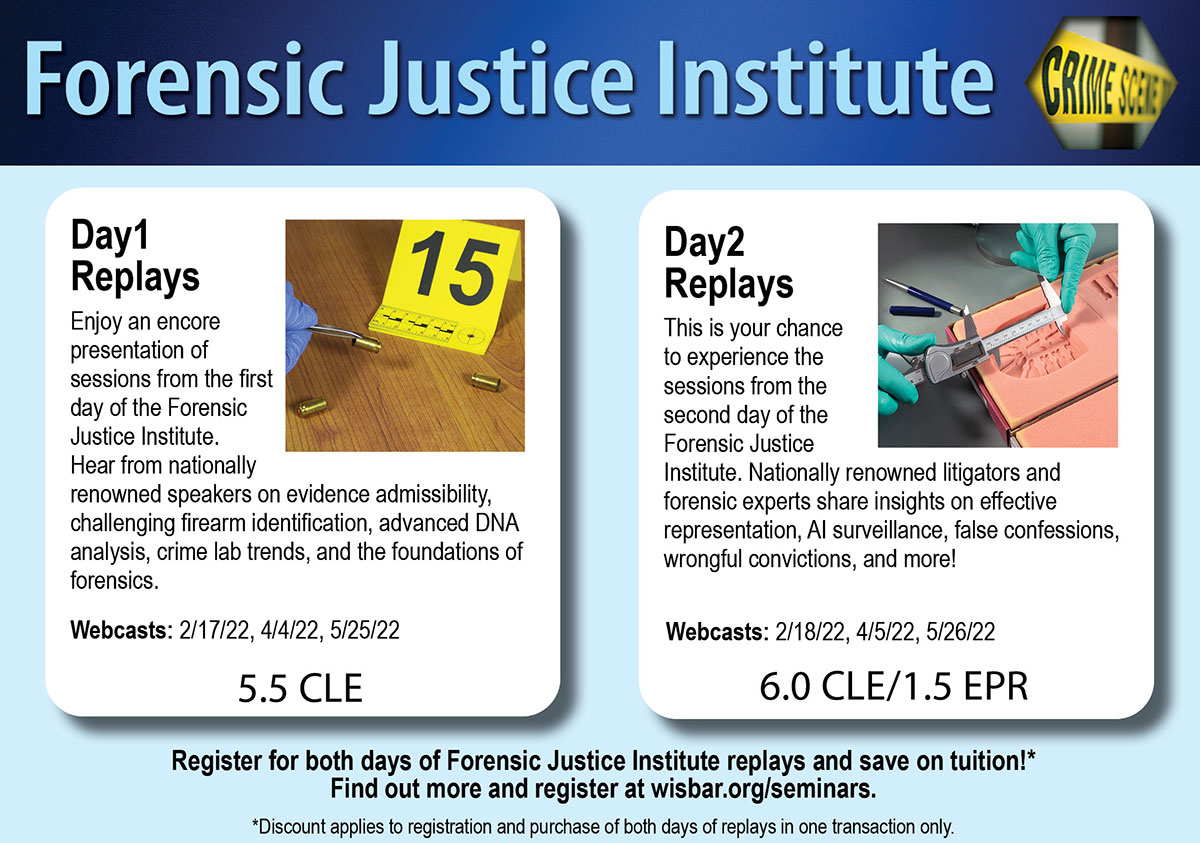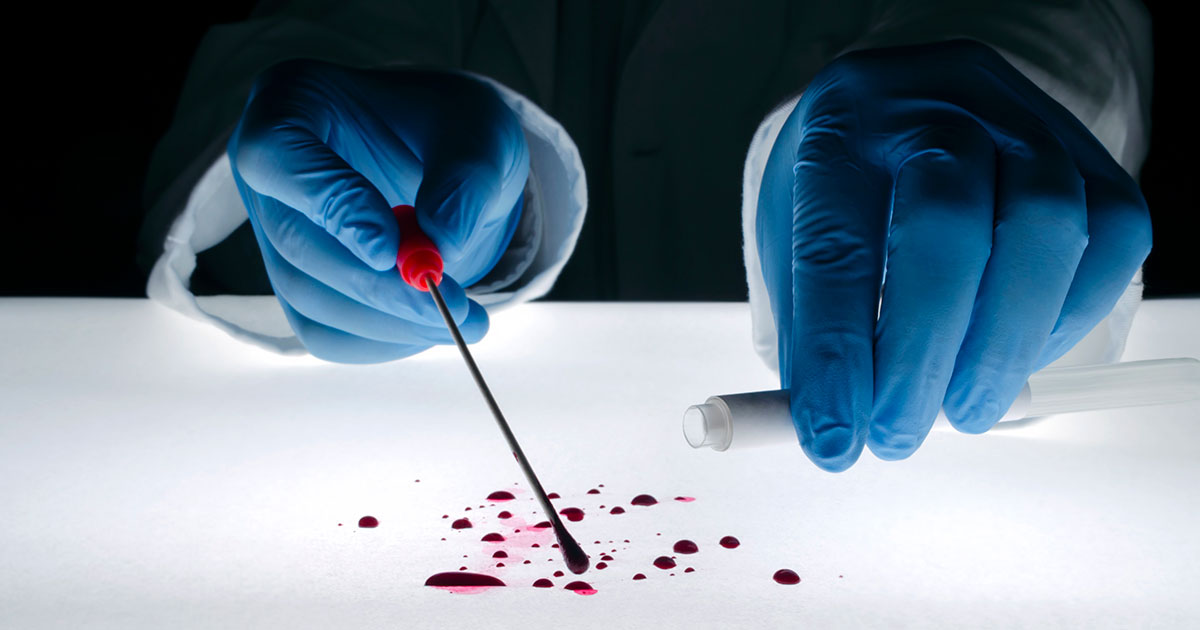
Feb. 2, 2022 - Misapplication of forensic science was a significant factor in 45 percent of exonerations won by the Innocence Project to date, according to Innocence Project co-founder Peter Neufeld.
Neufeld, a U.W.-Madison graduate, gave opening remarks at the recent
Forensic Justice Institute (Jan. 20-21), presented by State Bar of Wisconsin PINNACLE® in partnership with the Wisconsin-based Center for Integrity in Forensic Sciences.
The institute featured 17 presenters in 11 sessions, providing an unbiased look at the types of forensic science that often finds its way into evidence in criminal trials.
No Controls
During its 29-year history, the Innocence Project has helped exonerate 375 people using post-conviction DNA testing. Neufeld said one factor is a lack of regulation in the field of forensic science.
 Jeff M. Brown is a legal writer for the State Bar of Wisconsin, Madison. He can be reached by
email or by phone at (608) 250-6126.
Jeff M. Brown is a legal writer for the State Bar of Wisconsin, Madison. He can be reached by
email or by phone at (608) 250-6126.
Neufeld drew an analogy between the process for regulating pharmaceuticals and other medicines and the process for regulating forensic evidence.
“A system was set up which included hundreds of millions of dollars for basic and applied research; extensive peer review in the literature; people attempting to replicate the experiments and then refuting them if they couldn’t’; a federal agency called the FDA that said ‘You have to pass muster with us before your product can be used with the public.’"
“None of those controls existed in forensic science – none of them,” Neufeld exclaimed. “All that mattered was that one lawyer – who was probably not that literate scientifically – had the better argument in a court of law, where a scientifically illiterate judge accepted the argument and allowed the evidence to come forward, where it would be heard by a scientifically illiterate jury, and major decisions about life and liberty would be made.”
More rigorous science was required for approving medicines, Neufeld said, because the constituency was so broad; everybody cares about public and personal health, regardless of racial and socio-economic background.
“When you have that kind of constituency, you get the kind of regulatory scheme that we all want. But in the criminal legal system, the constituency is criminals or alleged criminals. They don’t have any lobbying power, so nobody gave a damn for so long.”
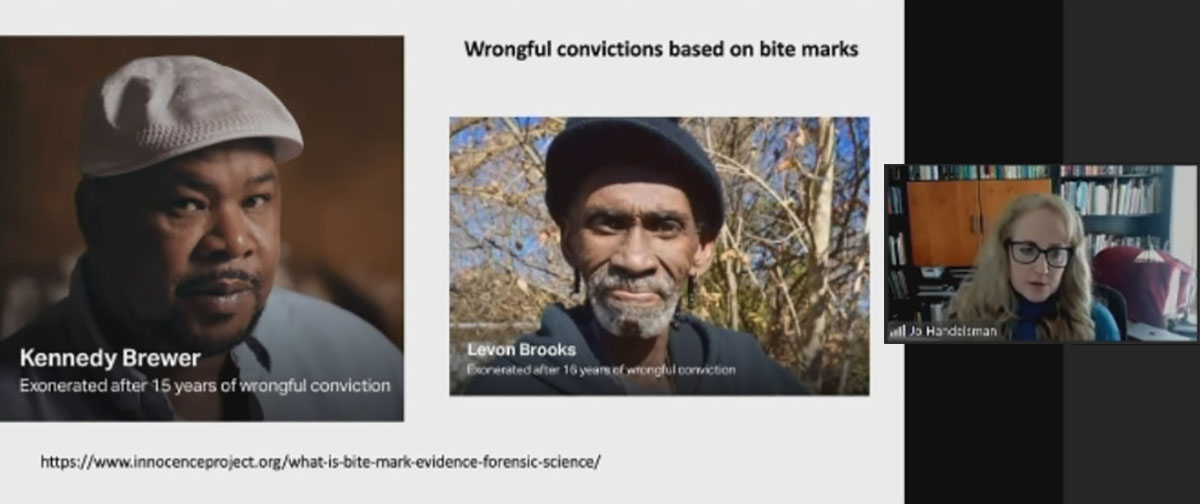
Jo Handelsman, a molecular biologist, told the story of two men who were wrongfully convicted based on flawed bite mark analysis. In each man’s case, bite marks on the victim that were matched to the wrongfully convicted man’s teeth were later determined to have been made by crayfish.
Change At Last
Neufeld said that’s now beginning to change.
Two drivers of that change are the rise of the “innocence movement,” along with the knowledge that forensic science has flaws – flaws that all too often lead to the conviction of innocent people.
Another driver is a broader understanding of the science among lawyers, particularly forensic science. Neufeld said the purpose of the Forensic Justice Institute was to “demystify” forensic science for attendees.
“If it accomplishes that, and you as a result of these sessions have the confidence in yourself and the willingness to learn what needs to be learned, you’ll be able to ask the right questions, you’ll be able to spot the relevant issues and if you do, then you’ll be able to seek out the necessary expertise to help you deal with the problems in your cases.”
Law vs. Science
Molecular biologist Jo Handelsman, a U.W.-Madison professor and the director of the Wisconsin Institute for Discovery, presented on the differences between science and the law.
Handelsman, who served as the associate director of science at the White House Office of Science and Technology (2014-17), told attendees that the practice of law and science are alike in that both rely on observation and evidence to draw conclusions.
But the practice of law is different in several crucial aspects: it sets out to prove a position in an adversarial system; there is no requirement that all available data be used; there is no requirement that evidence be subject to controlled experiments with indicia of repeatability; and rarely is a hypothesis falsified, something that’s a hallmark of science.
“We never really prove anything,” Handelsman said, “and a hypothesis can often be falsified long after it has become a commonly accepted concept.”
Another difference, Handelsman said, is the pace and the method at which the law – which strives for consistency to better guide society – changes.
“Law can be changed. It’s slow and it’s rare, but it’s an argued opinion that changes it rather than the kind of data that science would use.”
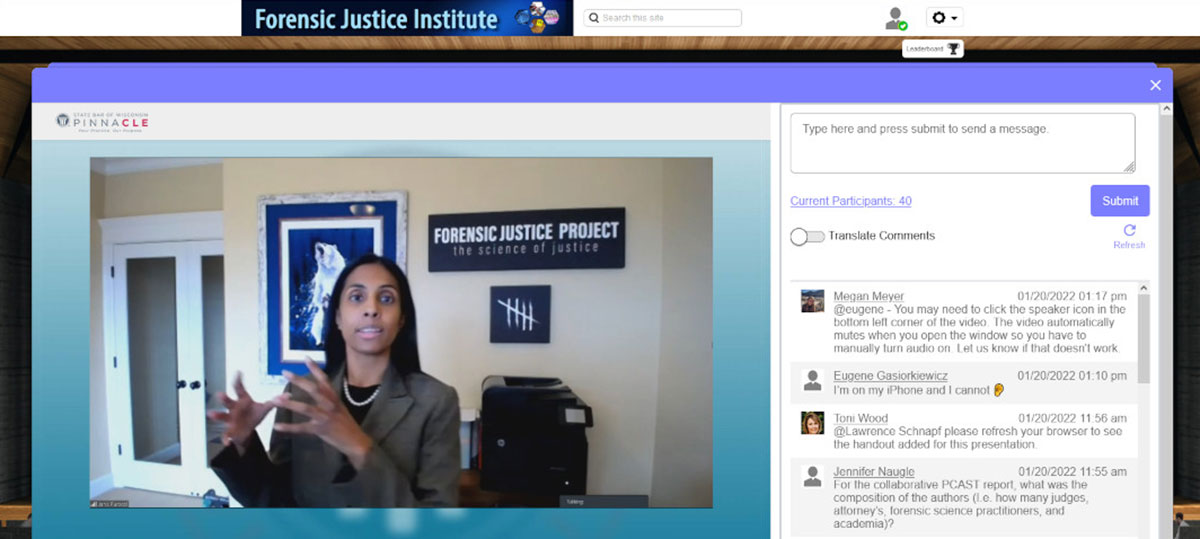
Trial lawyer Janis Puracal explained how implicit biases and improper contextual information can mar the results of firearms analysis.
‘Aching Problems’
One priority that marked Handelsman’s tenure at the White House Office of Science and Technology Policy was a reevaluation of the state of forensic science. The reevaluation was part of an effort to solve some of the “aching problems that underpin forensic technology,” Handelsman said.
She cited bite-mark analysis as one type of forensic science that failed to meet the scientific standards of verifiability, repeatability, and reliability.
A National Academy of Sciences Report in 2009 found little agreement on the validity of bite-mark analysis, Handelsman said.
For instance, it was difficult to verify whether bite marks were made by humans or animals; whether images of bite marks where capable of meaningful analysis; and whether the marks were actually bite marks.
Additionally, Handelsman said, the study found that the more experience analysts had, the less likely they were to agree on the interpretation of a particular bite mark.
“That would suggest it’s not a matter of training ... this was seemingly random across the examiners who were queried,” she said.
Handelsman cited two wrongful convictions that resulted from a reliance on bite-mark analysis. Each man had been convicted of the murder of a little girl.
When the real killer of the girls was caught, he said he hadn’t bitten the victims. But he had disposed of their bodies in rivers.
An animal bite-mark analyst then determined that the bite marks were made by crayfish. That knowledge led to the two men being exonerated.
The Role of Implicit Bias
Firearms analysis is another area of forensic evidence whose flaws are becoming more apparent.
Janis Puracal, a trial lawyer and executive director of the
Forensic Justice Project, told attendees that ballistic analysis – matching the twist and grooves on a bullet to the barrel of a specific gun – is a subjective proposition that can be marred by implicit bias.
For instance, an analyst’s knowledge of the identity of a suspect can affect his or her examination.
“If the examiner already believed that a 6’4” Black man committed this crime, the examiner’s eyes will focus on what looks the same in those bullets and completely disregard what looks different, or they’ll just explain it away.”
In an upcoming
paper, Puracal and a co-author make the point that firearms and other types of pattern-matching analysis (including the analysis of tool mark impressions, bloodstains, and footwear and tire impressions) are inherently subjective because they depend on the examiner’s judgment rather than an objective standard.
In the paper, Puracal asserts that examiners are sometimes predisposed to results-driven opinions by irrelevant contextual information, like the identity of a suspect.
Compounding the problem is the fact that bias is hard to see because it is both unspoken and the product of decades of social and cultural learning, Puracal said.
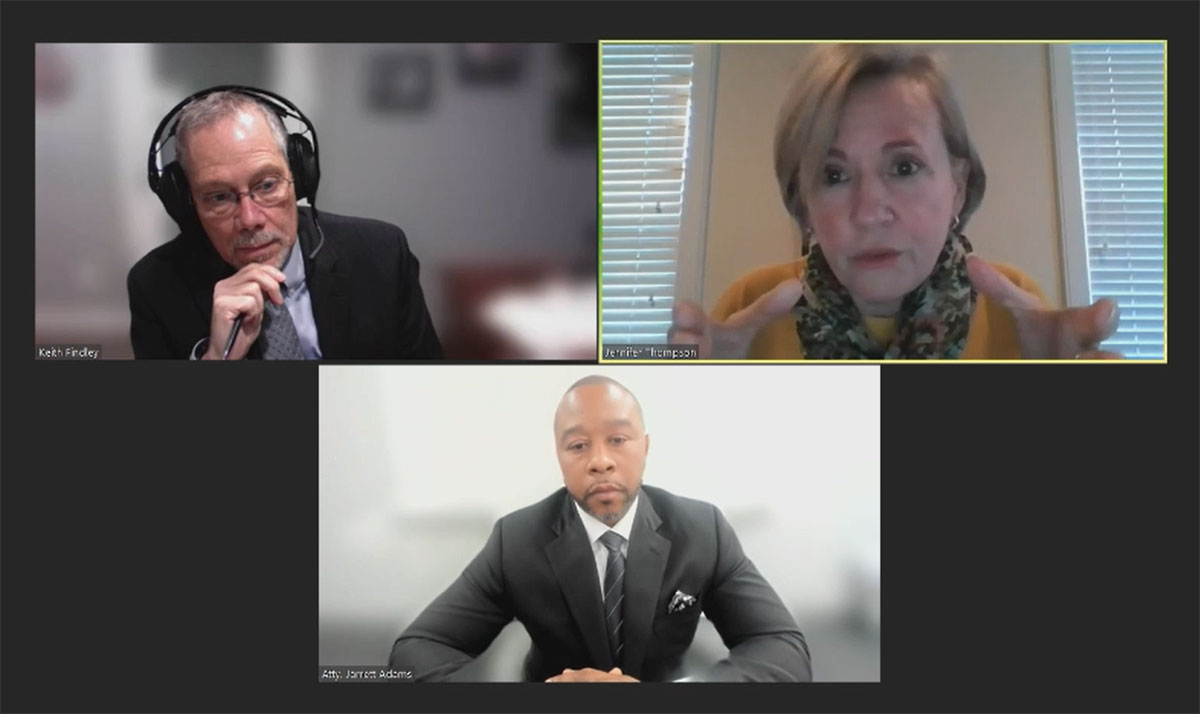
Keith Findley (left) led a panel discussion about the harm caused by wrongful convictions with authors Jennifer Thompson (right), and Jarrett Adams (bottom).
‘I Feel Like I’m Going to Hell’
The event concluded with a panel discussion led by Keith Findley, a professor at the University of Wisconsin Law School and co-founder of the Wisconsin Innocence Project.
Jennifer Thompson, co-author of the
New York Times Bestseller “Picking Cotton,” talked about the concentric circles of harm created by wrongful convictions.
Thompson wrote the book with Ronald Cotton, the man who was wrongfully convicted of raping Thompson based on eyewitness testimony that was the result of a flawed investigatory process.
Thompson said the harm created by wrongful convictions extends beyond defendants, witnesses, and victims.
“We know jurors are incredibly harmed. They’re given inadequate information, false information, no information – lies – and they’re asked to render a verdict based on non-truth.
“We’ve talked to jurors who have said, literally, ‘I feel like I’m going to go to hell because of what I did .... I feel like I need to commit suicide to atone for what happened.’”
‘It Isn’t About the Truth’
Thompson’s co-panelist Jarrett Adams wrote “Redeeming Justice” after being wrongfully convicted in Wisconsin of a sexual assault when he was 17 years old.
Adams, who’s Black, had his conviction overturned by the U.S. Court of Appeals for the Seventh Circuit because the police didn’t disclose an exculpatory police report to Adams’ lawyer. The experience motivated Adams to go to law school and become a criminal defense lawyer.
But there was more at play than the quantum or quality of evidence in his case, said Adams, as it so often the case with wrongful convictions in America.
“As I’m listening to this lawyer talk, I’m looking across at my mom, and I’m thinking about the creases of anguish that are lined on her forehead, “Adams said. “I’m thinking about how she has a different understanding about what’s going on and what’s at play because of the historical outcomes and depictions of African-American men who are accused of assaults on white women.
“My mom knew through experience what I would come to see: It isn’t about the truth – it’s about what’s accepted and proven in court.”
Adams said that the type of evidentiary flaws that typified his case continue to plague our criminal justice system.
“My perspective is one that is unique. I went through it, and now I’m helping others through it. And the shocking thing is, the same hallmarks still exist.”
